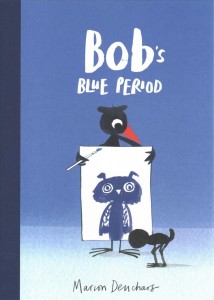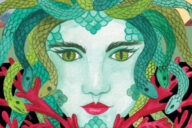Como manda a tradição, o Deus Me Livro apresenta aos leitores os títulos que as editoras prepararam para o assalto às livrarias nestes primeiros meses de 2019. Seguem-se as novidades cozinhadas pela Editorial Bizâncio, à boleia de sinopses e press releases.
—
Março
 “O Período Azul do Melro” | Marion Deuchars
“O Período Azul do Melro” | Marion Deuchars
Um livro da mesma autora de “O Melro Artista”.
Sinopse (não traduzida)
Bob the bird loves to paint pictures with his best friend Bat. But one day Bat goes away and Bob is sad. He tries to paint, but everything he paints is blue! Can his friends help him to find his bright colours again?
Abril
“O livro que diz «Não!” | Cédric Ramadier e Vincent Bourgeau
Os mesmos autores de “O Livro com Sono”, “O Livro Zangado” e “O livro com Medo”.
Sinopse (não traduzida)
Cette petite chipie aux cheveux frisés n’a qu’un mot à la bouche lorsqu’on lui demande quelque chose : « NON ! ». Finir son assiette, dire « s’il te plait », aider à débarrasser la table, ranger sa chambre, aller se brosser les dents, mettre son pyjama… On a beau lui demander n’importe quoi, la réponse est la même : « Non, non, non et NON ! » Alors, comment faire en sorte qu’elle obéisse ? Et s’il suffisait de jouer son propre jeu?
À l’âge du « Non », les enfants sont dans l’opposition systématique. Avec simplicité et humour, cet album aux illustrations pétillantes permet d’appréhender de manière dédramatisée cette phase d’opposition qui fait tant rire et qui agace, mais qui est pourtant essentielle à la construction psychique des petits.
Maio
O Grande Livro das Aves | Yuval Zommer
O mesmo autor de “O Grande Livro dos Insetos”, “O Grande Livro dos Animais” e “O Grande Livro dos Oceanos”
Sinopse (não traduzida)
Why is a flamingo pink? Can a parrot talk? Is a bald eagle really bald? This follow-up to the hugely successful The Big Book of Bugs, The Big Book of Beasts and The Big Book of the Blue answers these questions and many more. It opens with introductory spreads explaining how to recognize different bird’s eggs, the bird family tree, why different species of birds have different beaks and feathers, and why some birds migrate and travel vast distances every year. Subsequent spreads, illustrated with various habitats, are dedicated to specific varieties of bird, including hummingbirds, peacocks, flamingos, bald eagles, secretary birds, albatrosses and red-crowned cranes. Some will teach children how to spot different birds within a specific variety, for example how to differentiate the American robin from the European robin. Others explore bird habitats, for example showing how birds adapt to live in cities. Finally, the book invites young bird spotters to protect birds where they live and make their gardens bird friendly. This is a big, beautiful book to look at again and again.











Sem Comentários